Land Use
...now browsing by category
Monday, May 22nd, 2017
by Joe Dawson

Dennis Whigham samples horsetail plants in an Alaskan headwater stream. Credit: Ryan King/Baylor University
In Alaska, fish mean serious money. For fishermen, landowners, and the government, learning all they can about the lives of salmon could pay off in future fish harvests. There’s a lot to learn, down to how a single type of tree impacts their habitat.
The story of those habitats and trees, the alders, has been explored by SERC senior scientist Dennis Whigham and colleagues in a new study published May in Science of the Total Environment. The researchers have been studying interactions between watersheds and headwater streams for almost two decades.
Alders are most recognizable for their egg-shaped, serrated leaves. Their bark is used for tanning leather, and their wood to smoke salmon and make Fender guitars. But alders also have an outsized effect on their natural environment, transforming the chemistry and structure of wetlands and streams nearby. Bacteria in alder roots make nitrogen, an important plant nutrient, available in places where it is otherwise scarce. This can send ripple effects through entire ecosystems. In another plot twist, scientists also expect alder trees to expand northward, stirred by warmer temperatures and higher carbon dioxide from climate change. Whigham’s findings highlight the interconnectedness of wetland ecosystems, waterways, and the valuable fish that call Alaska home. Click to continue »
Posted in Alaska, Fisheries, Land Use, Publications | Comments Off on Alaskan Alders Shape Fates of Wetlands, Streams—And Salmon
Tuesday, November 22nd, 2016
by Emily Li
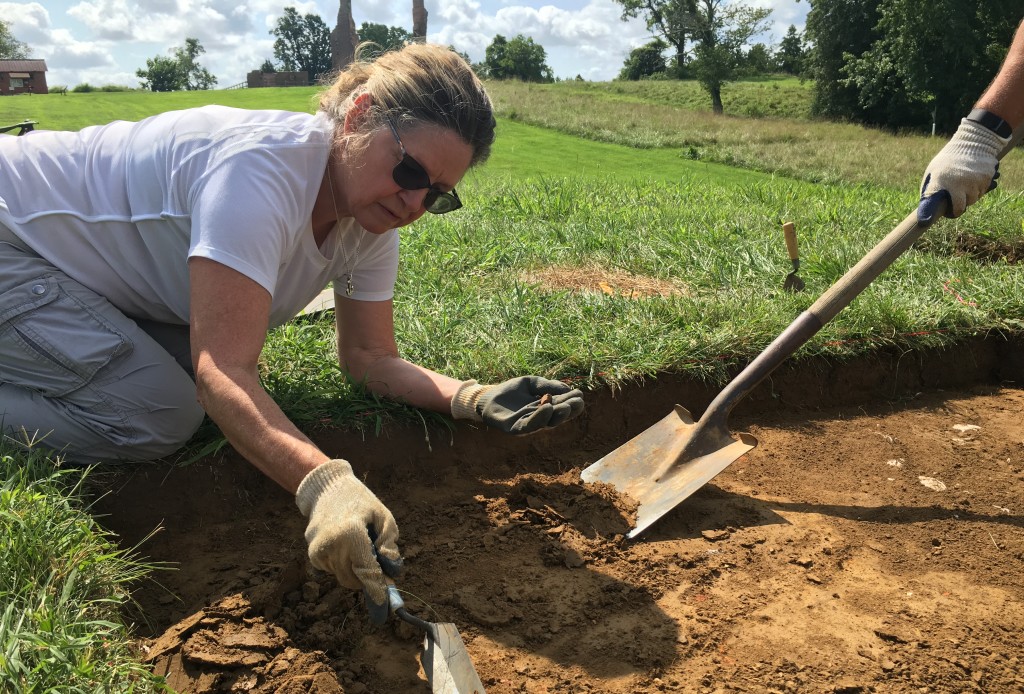
Citizen scientist Linda Perkins helps excavate a soil plot in front of the Contee mansion ruins. (Photo: SERC)
People don’t usually think of archaeologists as dumpster divers. Then again, sifting through trash for hidden treasures is exactly what the volunteer citizen scientists of the Smithsonian Environmental Research Center (SERC) Archaeology Lab do every Wednesday. But they don’t scavenge anything for themselves. (The market for millenia-old oyster shells is very unpredictable, and any food they find is always up to three centuries past its expiration date.) Instead, they take away new skills and a chance to put together a historical puzzle larger than themselves.
“We look back thousands of years,” said Jim Gibb, the lead volunteer and coordinator of the lab. “I always tell people—we’re the time lords.” Click to continue »
Posted in Archaeology, Citizen Science, Ecology, Land Use, Programs, SERC Sites and Scenes | Comments Off on Time Lords and Ladies of History’s Trash
Friday, August 12th, 2016
by Emily Li, science writing intern
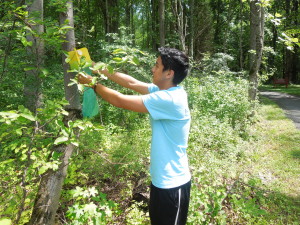
SERC intern Cole Caceres collects Japanese invasive beetles from a hormone trap for his experiment (Photo: Emily Li/SERC)
Smithsonian Environmental Research Center (SERC) intern Cole Caceres has two passions: science and cooking. He enjoys doing research and adding to the larger body of knowledge, but he hasn’t given up on owning his own restaurant. When he’s not studying nitrogen filtration as a laboratory assistant at the University of California, Davis, he’s probably watching Food Network or frying chicken wings in a sweet soy sauce glaze.
But Caceres found the perfect mix of his interests as an intern with SERC’s Terrestrial Ecology Lab. There, he cooks for invasive Japanese beetles, hoping to help shed light on their dietary preferences so that plant conservation initiatives can be more fully informed—one beetle bite at a time.
Click to continue »
Posted in Ecology, Interns, Interviews, Invasive Species, Land Use, SERC Sites and Scenes | Comments Off on Food for Thought: Cooking for Invasive Beetles
Friday, August 12th, 2016
By Emily Li, science writing intern
You might have heard of The Giving Tree, a children’s picture book by Shel Silverstein about a boy and a tree. As the boy grew, he began to want more from the tree, and the tree happily gave and gave and gave: her apples, her branches, and even her trunk. While Silverstein’s heartbreaking story was a fiction, the plot is happening in wetlands around the world—and this time, it’s for real. Marshes improve water quality, mitigate hurricane damage, sequester atmospheric carbon, and serve as ideal habitats and nurseries for wildlife. In return, as sea levels rise, they’re in line to be the first casualties.

SERC intern Jefferson Riera shows off his sunburn after a day in the field. (Photo: Emily Li/SERC)
That said, marshes are hardly a serene paradise. To Smithsonian Environmental Research Center intern Jefferson Riera, wetlands are ruined shoes caked in mud. Wetlands are wasp stings on his lips. Wetlands are spider webs of scratches from marsh vegetation. Wetlands are sunburns so severe his skin doesn’t match itself anymore.
And yet, he knows that they’re worth protecting. That’s why he, and the rest of SERC’s Ecological Modeling Lab, are working to develop a baseline understanding of local marsh elevation to educate policymakers on the state of wetlands—before their fates are sealed by the sea.
Click to continue »
Posted in Climate Change, Ecology, From the Field, Interns, Interviews, Land Use, SERC Sites and Scenes | Comments Off on Sink or Swim? Divining the Fate of Life-Giving Wetlands
Monday, August 8th, 2016
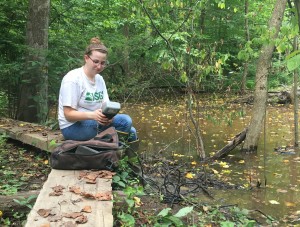
SERC intern Lauren Mosesso takes a water quality reading (Photo: Emily Li/SERC)
by Emily Li
One year ago, a team of scientists at the Smithsonian Environmental Research Center set out to restore a stream running through its campus in Edgewater, Md. No one ever said it would be simple.
At first glance, the restoration of Muddy Creek seems to be a closed case. Before the project began, the creek’s severely eroded banks were disconnected from its floodplains, turning the stream into a raging river during storms that stripped nutrients from the system and dumped them in the Chesapeake Bay. Now, after a facelift in January, the creek is nearly unrecognizable. Its gentle banks cradle the wide, slow-moving stream littered with leaves, ferns, and an abundance of other plant life. Choruses of croaks fill the air, accompanied by the hum of insects, bird chatter, and the occasional splash of frogs retreating into the cloudy water.
But another layer of mystery is clouding the waters. A mat of red Leptothrix bacteria coats some sections of the site, leading SERC senior scientist Dr. Thomas Jordan and his colleagues to ask a host of new questions. Are the bacteria harmful to the ecosystem, or an important part of the food web? Are they a short-term phenomenon or a permanent fixture to the stream? Exactly how much area do they cover? One SERC intern is hoping to find out.
Click to continue »
Posted in Ecology, From the Field, Interns, Interviews, Land Use, SERC Sites and Scenes, Water Quality | 1 Response »
Friday, July 22nd, 2016
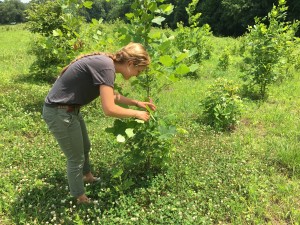
Anna Nordseth surveys clay caterpillars for predation damage in BiodiversiTREE plot (Credit: Emily Li/SERC)
by Emily Li
Anna Nordseth, a summer intern for the Smithsonian Environmental Research Center’s Terrestrial Ecology Lab, wasn’t surprised to be taking work home the first week and a half of her internship. What she wasn’t expecting was to be making nearly a thousand clay caterpillars.
Each caterpillar began life as a half gram of green clay, with a wire spine and ends rolled into a worm-like silhouette. By the time Nordseth had finished—several podcasts and three seasons of House of Cards later—she had 900 caterpillars and the hand cramps to prove it. But she was ready to begin her research.
Click to continue »
Posted in Climate Change, Ecology, From the Field, Interns, Interviews, Land Use, SERC Sites and Scenes | Comments Off on How Clay Caterpillars Help Unlock Biodiversity’s Secrets
Monday, July 18th, 2016
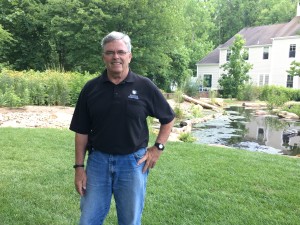
Tony Dove in the garden pond in front of the SERC Administration Building. (Photo: Emily Li/SERC)
by Emily Li
What do we do when native plants lose? About five years ago, the Smithsonian Environmental Research Center and the U.S. Department of Agriculture joined forces to back up seed sources of native plant species, just in case something threatens to wipe them out—but for some species, it looks like we might need them sooner rather than later. Learn more about the partnership and the pros of gardening with natives in this edited Q&A with Smithsonian Environmental Research Center horticulturalist Tony Dove.
Can you tell me about the native sentinel plant species partnership between SERC and the Department of Agriculture?
The Department of Agriculture has a woody plant germplasm conservation center in Beltsville. And what they do is they go around to different locations throughout the country and they collect seeds of various native plants. They grow those native plants in a nursery with the expectation that they will then take those plants and put them out into landscapes in different areas, so that there will always be a seed source for those particular plants if something tragically happens in the area where those plants grew.
Click to continue »
Posted in Ecology, Interviews, Invasive Species, Land Use, SERC Sites and Scenes | Comments Off on Q&A: Preparing a Safety Net for Native Plants
Wednesday, February 3rd, 2016
by Kristen Minogue
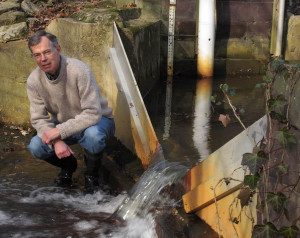
Tom Jordan beside a V-shaped weir that tracks nutrients in a SERC stream. (SERC)
For years, a team of scientists has been trying to solve a mysterious disappearance at a drainage ditch on the Choptank River Basin, on Maryland’s eastern shore. Every year roughly 32,000 pounds of human-generated nitrogen enters the ditch’s watershed, from fertilizers, air pollution and other sources. But less than a third of that nitrogen typically flows out of the stream.
Tom Jordan has seen it before. A nutrient ecologist at the Smithsonian Environmental Research Center (SERC), Jordan has wrestled with the mystery of the missing nitrogen for more than twenty years.
“It feels like a sort of fatal attraction,” Jordan said. Two decades of trial and error and dead ends only fueled his determination to find answers. Now, according to a new January study, Jordan and his colleagues finally have some.
Click to continue »
Posted in Ecology, Land Use, Publications, Water Quality | 2 Responses »
Tuesday, December 22nd, 2015
by Kristen Minogue
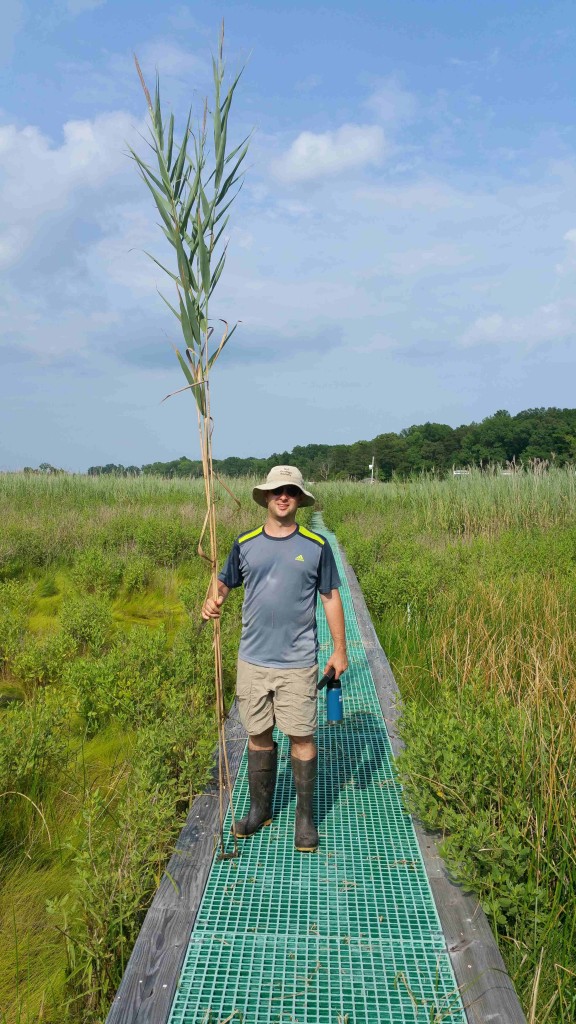
Ecologist and lead author Josh Caplan holds a Phragmites plant at the Global Change Research Marsh. Invasive Phragmites can grow up to 15 feet tall. (Thomas Mozdzer)
One of the Chesapeake’s least favorite invaders could end up being an unlikely savior. The invasive reed Phragmites australis, a plant that has exploded across Chesapeake wetlands in the last few decades, is also making those wetlands better at soaking up carbon, ecologists from the Smithsonian Environmental Research Center (SERC) and Bryn Mawr College discovered in a new study.
The common reed, better known as Phragmites australis, grows in dense clusters up to 15 feet tall. North America has several native strains that have co-existed peacefully with many other native plants for at least 30,000 years. It is the invasive strain that arrived from Eurasia in the 1800s that has scientists and environmental managers worried. Eurasian Phragmites grows taller and denser than North American Phragmites, crowding out many smaller plants, and blocking access to light and nutrients. These changes in plant community have a ripple effect on animals that rely on wetlands for habitat.
“The fish communities, the insect communities, the soil and invertebrate communities, all these things change when Phragmites comes in,” says lead author Josh Caplan, a Bryn Mawr postdoc and visiting scientist at SERC. Often, those changes aren’t for the better. “Phragmites is doing a number to these ecosystems.” Click to continue »
Posted in Climate Change, Ecology, Invasive Species, Land Use, Publications, SERC Sites and Scenes | Comments Off on Phragmites vs. Climate Change: Invasive Reed Better at Taking Up Carbon
Friday, August 28th, 2015
by Heather Soulen
The Need for Healthy Marshes
Ten years ago, on August 28, 2005, Hurricane Katrina nicked south Florida and entered the heat-charged waters of the Gulf of Mexico, transforming from a Category 1 hurricane into a super-charged Category 5. In the early morning hours of August 29, it ripped through Louisiana and Mississippi. Thousands died, and hundreds of thousands of homes and businesses were destroyed. Today, much of the Louisiana and Mississippi coasts, and its people, are still recovering from the devastation.
When Katrina hit, some coastal marshes east of the Mississippi River lost approximately 25 percent of their area. In the decade that followed, salt marshes and wetlands in Louisiana have continued to disappear in some places, but not others. The scientific community soon zeroed in on keeping marshes healthy, since, as one scientist remarked “A healthy marsh is pretty resilient, A stressed marsh – storms will physically break the marsh down.” Marshes and wetlands are ecologically and economically important ecosystems. During storms they act like buffers, reducing storm surge and flood damage, but only if they’re healthy. The question is, what factors make a marsh strong or weak?
Click to continue »
Posted in Climate Change, Ecology, Invasive Species, Land Use, Publications | Comments Off on Remembering Hurricane Katrina by Studying Marshes of the Future
Tags: carbon dioxide, climate change, genetic diversity, Hurricane Katrina, hurricanes, management, marsh, nitrogen, nutrients, sea-level rise, Spartina










